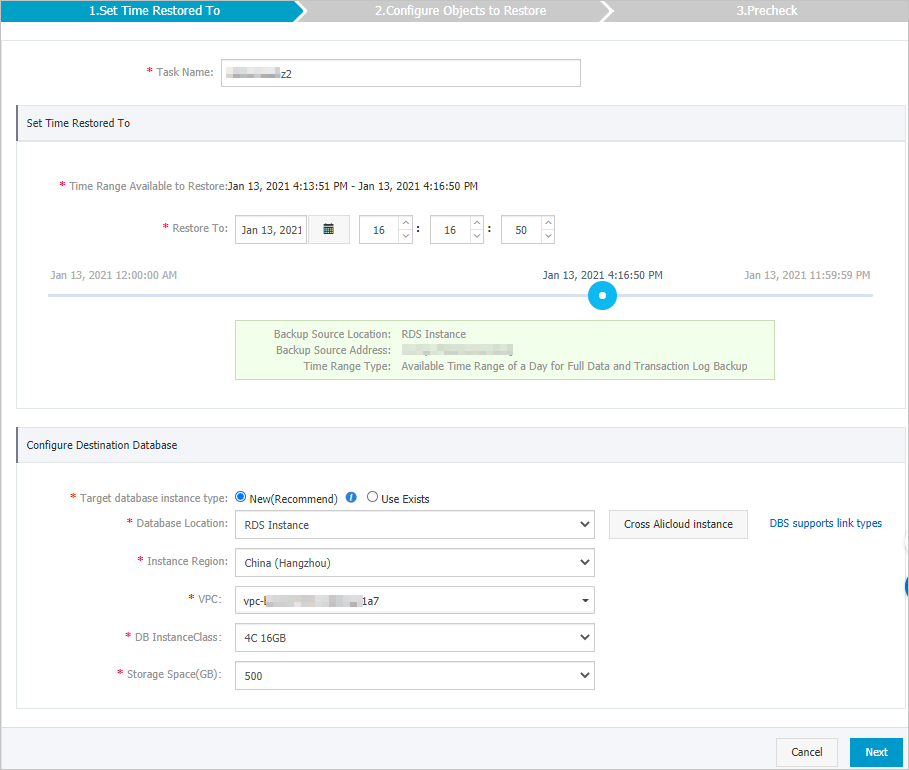このトピックでは、データベースバックアップ (DBS) を使用して論理バックアップからMySQLデータベースを復元する方法について説明します。
前提条件
MySQLデータベースがバックアップされます。 詳細については、「論理バックアップを使用したApsaraDB RDS For MySQLインスタンスまたは自己管理型MySQLデータベースのバックアップ」をご参照ください。
使用上の注意
既存のデータベースインスタンスにデータを復元する場合は、復元タスクの設定時に指定したデータベースアカウントに、ターゲットデータベースに対する権限が付与されていることを確認します。 そうしないと、復元タスクが失敗する可能性があります。 詳細は、「アカウント権限」をご参照ください。
手順
データベースバックアップ (DBS) コンソールにログインします。
左側のナビゲーションウィンドウで、[バックアップスケジュール] をクリックします。 上部のナビゲーションバーで、リージョンを選択します。
[バックアップスケジュール] ページで、管理するバックアップスケジュールを見つけ、[操作] 列の [管理] をクリックします。
バックアップタスクの設定 ページで、右上隅の データベースの復元 をクリックします。
[復元タスクの作成] ウィザードの 復元時点の設定 ステップで、パラメーターを設定し、[次へ] をクリックします。 次の表にパラメーターを示します。
説明この例では、バックアップデータが新しいデータベースインスタンスに復元されます。 Targetデータベースインスタンスタイプパラメーターを 既存のインスタンスを使用する に設定した場合、さらにパラメーターを設定する必要があります。 詳細については、「論理バックアップを使用したApsaraDB RDS For MySQLインスタンスまたはセルフマネージドMySQLデータベースのバックアップ」トピックの表1をご参照ください。

セクション
パラメーター
説明
N/A
復元タスク名
復元タスクの名前。 DBSはタスク名を自動的に生成します。 タスクの識別に役立つ名前を指定することをお勧めします。 タスク名は一意である必要はありません。
復元時点
復元可能な時間範囲
最初の完全バックアップセットが作成された時点から最新の完全バックアップセットが作成された時点までの時間範囲。 データベースは、時間範囲内のある時点に復元することができる。
復元先
ソースデータベースを復元する時点。 値は、[復元可能な時間範囲] パラメーターで指定された時間範囲内である必要があります。
説明増分バックアップ機能が有効になっている場合、DBSを使用すると、最初の完全バックアップの完了から最後の増分バックアップの完了までの時点にデータを復元できます。
増分バックアップ機能が無効になっている場合、DBSを使用すると、完全バックアップが完了した時点にデータを復元できます。
宛先データベースの設定
対象データベースインスタンスタイプ
データを復元するデータベースインスタンスのタイプ。 有効な値: New(Recommend) および既存のインスタンスを使用する。
説明既存のインスタンスを使用する を選択した場合、復元操作を実行するときにターゲットデータベースが使用可能であることを確認します。
データベースの場所
新しいデータベースインスタンスの場所。 この例では、RDSインスタンスが選択されています。
インスタンスリージョン
新しいデータベースインスタンスが存在するリージョン。
[VPC]
新しいデータベースインスタンスがデプロイされている仮想プライベートクラウド (VPC) 。
説明VPCの作成方法については、「VPCの作成と管理」をご参照ください。
DB InstanceClass
新しいデータベースインスタンスのタイプ。 DBSコンソールに表示される使用可能なインスタンスタイプからインスタンスタイプを選択します。
説明ソースデータベースインスタンスと同じインスタンスタイプ、またはより高い仕様のインスタンスタイプを選択することを推奨します。
ストレージ容量 (GB)
新しいデータベースインスタンスのストレージ容量。 DBSコンソールに表示される使用可能なストレージスペースのサイズからサイズを選択します。
説明データベースインスタンスに復元に十分な容量を確保するために、ソースデータベースインスタンスのサイズの1.3倍以上、またはDBSフルバックアップセットのサイズの5〜6倍のストレージ容量を選択することを推奨します。 DBSがバックアップを実行するとき、データは圧縮される。
DBSコンソールで完全バックアップセットのサイズを確認できます。 DBSコンソールにログインします。 左側のナビゲーションウィンドウで、[バックアップスケジュール] をクリックします。 [バックアップスケジュール] ページで、ソースデータベースのバックアップスケジュールを見つけ、バックアップスケジュールの名前をクリックします。 左側のナビゲーションウィンドウで、 を選択します。 表示されるページで、完全バックアップセットのサイズを表示できます。 詳細については、「バックアップスケジュールの表示」をご参照ください。
国境を越えたデータ転送に関するコンプライアンス保証
コンプライアンスの声明を読み、私は読んで、上記のコンプライアンスのコミットメントに同意しますを選択します。
復元オブジェクトの設定 ステップで、次の表に示すパラメーターを設定し、事前チェックして開始する をクリックします。
パラメータまたは設定
説明
競合処理
デフォルトでは、[競合処理] パラメーターに [オブジェクトの名前を同じ名前で変更] が選択されています。 たとえば、復元中に
job_infoテーブルが別のテーブルと同じ名前を共有する場合、システムはデフォルトで新しいテーブルの名前をjob_info_dbs_<復元タスクID >_</timestamp>に変更します。復元するオブジェクト
[使用可能] セクションで復元するデータベースまたはテーブルを選択し、右矢印をクリックして [選択済み] セクションに追加します。
説明DBSを使用すると、単一のデータベースまたはテーブルを復元できます。 これは、復元されるデータの量を減らし、回復時間目標 (RTO) を短縮する。
[事前チェックに合格しました] メッセージが 事前チェック ダイアログボックスに表示されたら、今すぐ起動する をクリックします。
データベースの復元の進行状況を表示するには、左側のナビゲーションウィンドウで 復元タスク をクリックします。
説明データベースの復元に使用される時間は、バックアップスケジュールの仕様とデータベースのサイズによって異なります。 より高い仕様は、より高い復元速度を提供する。 詳細については、「バックアップと復元のパフォーマンステスト」をご参照ください。
データベースを新しいApsaraDB RDSインスタンスに復元する場合、DBSはインスタンスの作成に約5〜10分かかります。 データベースの復元後、ApsaraDB RDSコンソールで新しいApsaraDB RDSインスタンスを表示できます。 または、次の操作を実行して、新しいApsaraDB RDSインスタンスを表示します。[タスクの復元] ページで、復元タスクのIDをクリックします。 表示されるページで、[基本情報] セクションでApsaraDB RDSインスタンスのIDをクリックします。 ApsaraDB RDSコンソールに移動します。
関連するAPI操作
API操作 | 説明 |
復元タスクを作成します。 | |
復元タスクを開始します。 | |
復元タスクを表示します。 |